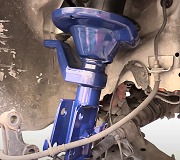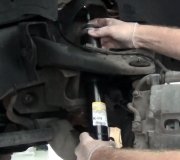Struts and shock absorbers have absolutely nothing to do with ride height. On a few car models they are adjustable for positioning the wheel as it tips in or out on top, as viewed from in front of the car. That is one of the three main alignment adjustments called "camber".
When you buy a replacement strut, on some of the cheapest ones you can push the shaft into the body and it will stay there. Almost all replacement struts are gas-charged. That pressure reduces foaming of the oil, and it causes the shaft to extend slowly when it is unpackaged. You can push that shaft back into the body with moderate hand pressure. How is that going to hold up 1,000 pounds of car weight?
You need to look at the coil springs. That is what sets the ride height on ninety nine percent of front-wheel-drive cars. When only one side of the car is sitting much too low, a broken spring is the best suspect. That is very dangerous because the sharp, pointed ends at the break can cut and shred the sidewall of the tire. The bottom of the spring sits on a plate welded to the strut body. That plate can be rusted too, allowing the corner to sit too low. That can also damage the rubber brake flex hose.
When both sides of the front end sit too low, it is more likely the springs are just sagged from age. Every tire and alignment shop, and most other repair shops will have a large wall chart listing every car model and year, what the ride height measurements should be, and where to take those measurements. If the car is sitting low, conscientious mechanics won't take your money for aligning it because they know there will still be excessive tire wear and poor handling. Altered ride height, especially on intentionally-lowered cars and raised trucks, changes the geometry of the steering and suspension systems, and it changes the tipping movements, (camber changes), the wheels go through as the car moves up and down over bumps in the road. The numbers can look perfect on the alignment computer, but that does not take incorrect ride height into consideration and its contribution to tire wear.
The best place to start is with an inspection at a tire and alignment shop. They will look for other worn parts and measure ride height. One place now that adds to your confusion about struts is replacing them or the coil springs presents a safety concern for the mechanic when working with compressed springs that could fly across the shop. A second concern is the upper strut mounts. Those are plates with small ball bearing assemblies that allow the struts to rotate as part of the steering system while supporting the entire weight of the car. Those can bind and cause a popping noise or sporadic hard steering, and the center hole can rust out. That rusted hole can not be seen until the spring is removed to replace the strut. That is when the mechanic has to tell you more parts are needed. We hate having to do that.
The binding or worn upper mount, sagged spring, worn strut, safety concern, and a broken / rattling plastic dust cap are all addressed by installing a pair of "Quick Struts. That is the complete assembly. You are getting a new strut, a new coil spring, a new upper mount, so it will cost a little more for the parts, but the mechanic will save a lot of time, so you save there too. In your case you get your new struts, but it is the coil springs that solve the ride height problem. If you elect to replace only the coil springs, the strut still has to be completely removed, then reinstalled, so it is silly to not install new ones at that time. Also, the new coil springs have to be compressed a lot so they can fit onto the strut. That adds an even greater safety concern for the mechanic. It is foolish to put new springs on old struts because you are not saving much money as the trade-off for less-than-ideal handling and ride quality.
An alignment will be required too, and that should be included in the repair estimate. If you follow the pages of procedures in the service manual, you might be able to install new Quick Struts yourself, but you will still need the alignment.
Friday, December 9th, 2016 AT 5:33 PM



